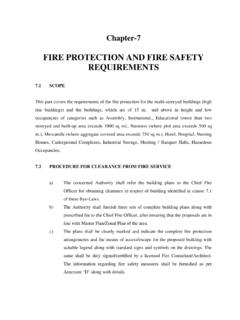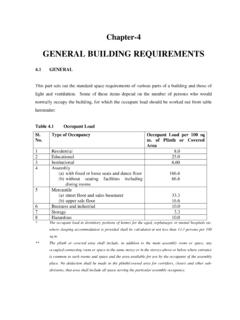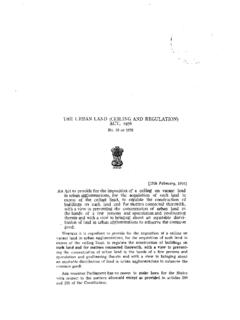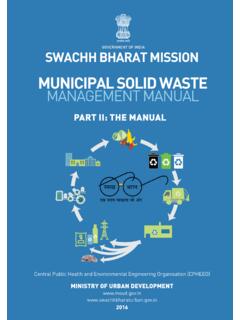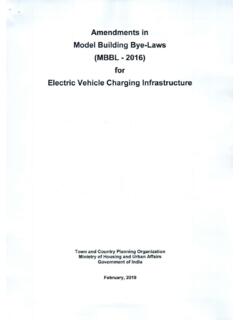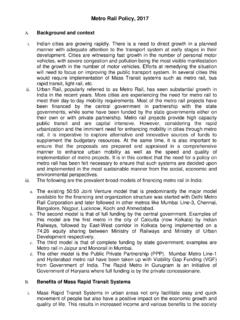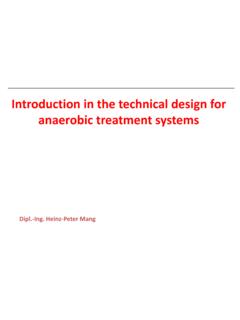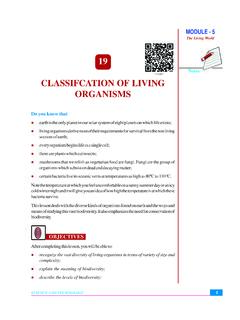Transcription of Chapter XIV - Composting
1 Chapter 14. Composting . INTRODUCTION. The organic content of Municipal Solid Waste (MSW) tends to decompose leading to various smell and odour problems. It also leads to pollution of the environment. To ensure a safe disposal of the MSW it is desirable to reduce its pollution potential and several processing methods are proposed for this purpose. Composting process is quite commonly used and results in production of a stable product - compost which depending upon its quality can be used as a low grade manure and soil conditioner. The process results in conservation of natural resources and is an important processing method, especially in agricultural and horticultural areas. In the case of individual households, small establishments and colonies, vermi- Composting which involves the stabilisation of organic solid waste through earthworm consumption for conversion of the organic material to worm casting is being increasingly preferred.
2 This process is discussed in detail in Chapter 16. PRINCIPLES OF Composting MANUAL AND MECHANISED. METHODS. Decomposition and stabilisation of organic waste matter is a natural phenomenon. Composting is an organised method of producing compost manure by adopting this natural phenomenon. Compost is particularly useful as an organic manure which contains plant nutrients (Nitrogen, Phosphorous and Potassium) as well as micro nutrients which can be utilized for the growth of plants (Gotaas 1956). When used in conjunction with chemical fertilisers optimum results are obtained. Composting can be carried out in two ways , aerobically and anaerobically. During aerobic Composting aerobic micro-organisms oxidise organic compounds to Carbon di oxide, Nitrite and Nitrate. Carbon from organic compounds is used as a source of energy while nitrogen is recycled.
3 Due to exothermic reaction, temperature of the mass rises. During anaerobic process, the 243. anaerobic micro organisms, while metabolising the nutrients, break down the organic compounds through a process of reduction. A very small amount of energy is released during the process and the temperature of Composting mass does not rise much. The gases evolved are mainly Methane and Carbon di oxide. An anaerobic process is a reduction process and the final product is subjected to some minor oxidation when applied to land. INDORE & BANGALORE METHODS OF Composting . Manual Composting was systematised by Howard & his associates. It was further developed by Acharya & Subrahmanyam and the methods are conventionally referred as Indore and Bangalore methods of Composting . Bangalore Method This is an anaerobic method conventionally carried out in pits.
4 Formerly the waste was anaerobically stabilised in pits where alternate layers of MSW and night soil were laid. The pit is completely filled and a final soil layer is laid to prevent fly breeding, entry of rain water into the pit and for conservation of the released energy. The material is allowed to decompose for 4 to 6 months after which the stabilised material is taken out and used as compost. Indore Method This method of Composting in pits involves filling of alternate layers of similar thickness as in Bangalore method. However, to ensure aerobic condition the material is turned at specific intervals for which a 60 cm strip on the longitudinal side of the pit is kept vacant ( ). For starting the turning operation, the first turn is manually given using long handled rakes 4 to 7 days after filling. The second turn is given after 5 to 10 more days.
5 Further turning is normally not required and the compost is ready in 2 to 4 weeks. In the urban areas, due to extensive provision of water carriage system of sanitation, night soil is not available. Composting of MSW alone is hence often carried out. Aerobic Composting of MSW is commonly carried out in windrows. Comparison of the Methods The Bangalore method requires longer time for stablisation of the material & hence needs larger land space, which is in short supply in urban areas. The gases generated in this anaerobic process also pose smell & odour problems. 244. The Indore method on the other hand stabilises the material in shorter time & needs lesser land space. As no odourous gases are generated in this process, it is environment friendly & hence commonly preferred. While the organic matter is stabilised during the Composting process, the moisture content also changes.
6 The non decomposables are also rejected. Hence the quantity of compost is much lesser than the input & is normally around 50%, and the exact value depends upon the characteristics of the input material. Windrow Composting The organic material present in Municipal Waste can be converted into a stable mass by aerobic decomposition. Aerobic micro organisms oxidize organic compounds to Carbon di oxide and oxides of Nitrogen and Carbon from organic compounds is used as a source of energy, while Nitrogen is recycled. Due to exothermic reactions, temperature of mass rises. In areas/regions were higher ambient temperatures are available, Composting in open windrows is to be preferred. In this method, refuse is delivered on a paved/unpaved open space but levelled and well drained land in 245. about 20 windrows with each windrow 3m long x 2m wide x high, with a total volume not exceeding Each windrow would be turned on 6th & 11th days outside to the centre to destroy insects larvae and to provide aeration.
7 On 16th day, windrow would be broken down and passed through manually operated rotary screens of about 25mm square mesh to remove the oversize contrary material. The screened compost is stored for about 30 days in heaps about 2m wide x high and up to 20m long to ensure stabilization before sale. FACTORS AFFECTING THE Composting PROCESS. Organisms Aerobic Composting is a dynamic system wherein bacteria, actinomycetes, fungi and other biological forms are actively involved. The relative preponderance of one species over another depends upon the constantly changing food supply, temperature and substrate conditions. Facultative and obligate forms of bacteria, actinomycetes and fungi are most active in this process. In the initial stages mesophilic forms predominate and thermophilic bacteria and fungi soon take over except in the final stage of Composting .
8 Except when the temperature drops, actinomycetes and fungi are confined to 5 to 15 cm outer surface layer. If the turning is not carried out frequently the actinomycetes and fungi in these layers register increased growth imparting it typical greyish white colour. thermophilic actinomycetes and fungi are known to grow well in the range of 45 to 60o C. Different organisms are known to play predominant role in breaking down different constituents of municipal solid waste. thermophilic bacteria are mainly responsible for the breakdown of proteins and other readily biodegradable organic matter. Fungi and actinomycetes play an important role in the decomposition of cellulose and lignin. The actinomycetes common in compost are Streptomyces sp. and Micromonospora sp. the latter being more prevalent. The common fungi in compost are Thermonomyces sp.
9 , Penicillium dupontii and Asperigallus fumigatus. Majority of these organisms responsible for Composting are already present in municipal solid waste. Not much information is available regarding the organisms active in anaerobic Composting , though many of the organisms responsible for anaerobic decomposition of sewage sludge will be active here also, and differences are expected due to the concentration of nutrients present and the temperature conditions. 246. Use of Cultures During the development of Composting process various innovators came forward with inoculum, enzymes etc., claimed to hasten the Composting process. Investigations carried out by various workers have shown that they are not necessary. The required forms of bacteria, actinomycetes and fungi are indigenous to MSW. Under proper environmental conditions the indigenous bacteria adapted to MSW rapidly multiply, as compared to the added cultures which are more attuned to controlled laboratory conditions and carry out decomposition.
10 The process is dynamic and as any specific organism can survive over a specific range of environmental conditions, as one group starts diminishing, another group of organisms starts flourishing. Thus, in such a mixed system appropriate life forms develop and multiply to keep pace with the available nutrients and environmental conditions. Hence, addition of similar and extraneous organisms in the form of inoculum is unnecessary. However, such inoculum will be required during Composting of industrial and agricultural solid waste which do not have the large mix of indigenous bacterial population. Moisture The moisture tends to occupy the free air space between the particles. Hence, when the moisture content is very high, anaerobic conditions set in. However, the Composting mass should have a certain minimum moisture content in it for the organisms to survive.

